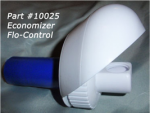Clearly having a water flow that moves around in direction is going to mix water up faster. The issue is whether this makes a practical difference if using a regular return still ends up mixing the water in a reasonable amount of time. This is something one can only readily determine through measurement of parameters such as chlorine level and temperature at various depths after varying amounts of time.
I know that I don't have this sort of circulator device and have measured both chlorine level and temperature at different depths (getting the chlorine sample at lower depth wasn't easy) and I've also done dye tests. In my own pool, the water mixes (circulates) quite well even at depths, but I have 3 returns, a skimmer, and 2 floor drains in my 16'x32' pool. Yes, I know that floor drains are said not to make much of a difference, but I think it's just relative to the efficiency of returns. That is, a return pointing downward is going to move water near the bottom more efficiently than a floor drain, but having a return only one foot below the surface pointed horizontally may not do much in the depths without a floor drain. My pool is diagrammatically as follows:
Code:
|---R----------------------S---|
| |
| |
| F |
| F |
R |
| |
|--------------------------R---|
In the above, the "R" returns (eyeballs) are one foot below the surface and pointed mostly horizontally perpendicular to the wall on which they are placed. The skimmer "S" is obviously at the water surface while the floor drains "F" are at the 6 foot deep end (the shallow end is 3 feet). I don't show the ramp in the pool where technically one of the shallow end returns exists. A picture of my pool is here. The returns most certainly produce a counter-clockwise flow pattern (from the top-view above) that is primarily to move surface debris to the skimmer and to get mixing from the shallow to deep-end and vice-versa. Were it not for the floor drains, it is not clear that the deep end of the pool would get good circulation unless I were to point the deep-end return downward. I suppose if I get a chance I can do another set of tests closing off the floor drains to see.
As for temperature heating efficiency, it is better to mix the water thoroughly during the day since hotter water evaporates faster and also loses more heat through convection/conduction as well. At night, however, it is better to shut off the pump and let the water somewhat self-insulate so that the surface layers get colder thereby slowing down the rate of heat loss. Of course, use of a pool cover at night would be the best; during the day it depends on humidity, temperature, wind and transparency of the cover as to whether a typical cover helps or hurts with net heating.
The bottom line is that doing experiments with and without The Circulator are the best way to determine its efficiency. When not using The Circulator, one can experiment with different orientations of returns, especially if there is no floor drain as with many above ground pools. We know we've seen algae develop even when chlorine levels were presumably OK in such pools and it usually has been due to poor circulation which was most easily fixed by pointing the return diagonally downward to produce a combination rotating swirling and down-up bounce pattern.
Freelancer's experiences are certainly real and if we get reasonably consistent positive reviews of this product then it would clearly be an alternative in pools that might otherwise have poor circulation. I like the fact that they have fixed the problem with aeration since that was something that bothered me about their initial design. It would also be better not to have the rotating pattern point as much upward during its rotation as it does downward because you don't want to break the water's surface very much or else that will contribute to pH rise from outgassing as well (to some extent, this product will increase this anyway due to better mixing, but keeping the surface tension of the water's surface mostly intact helps slow down air/water interchange).
Richard


